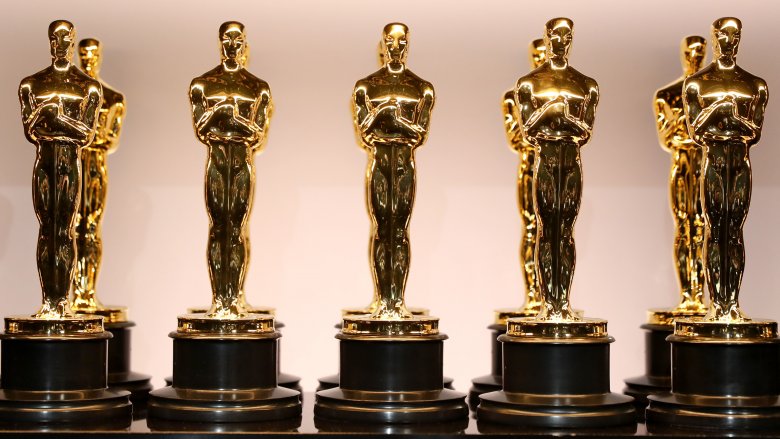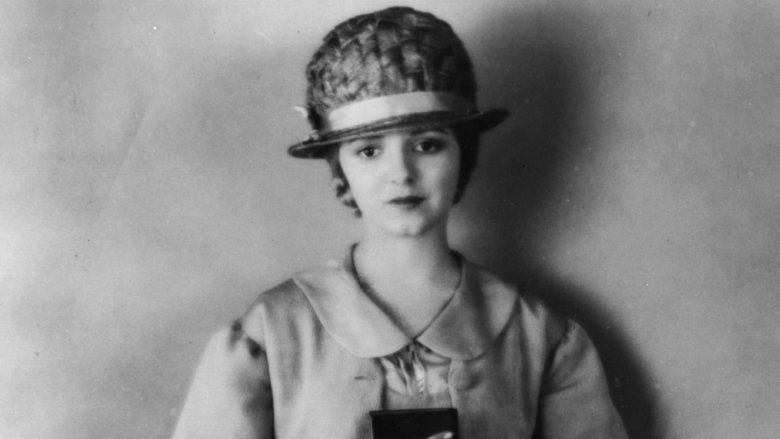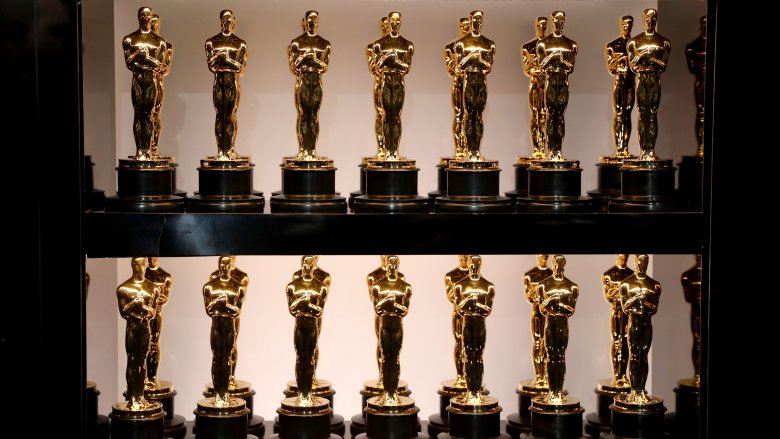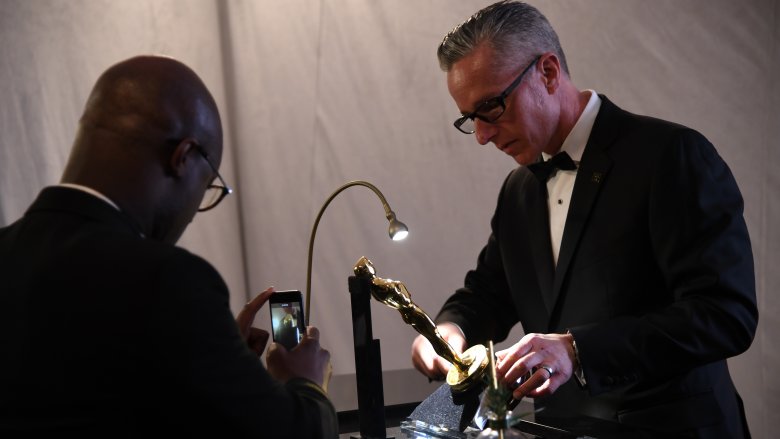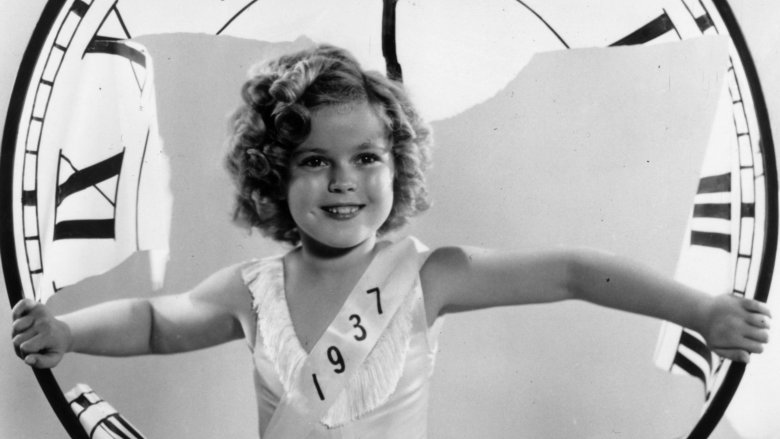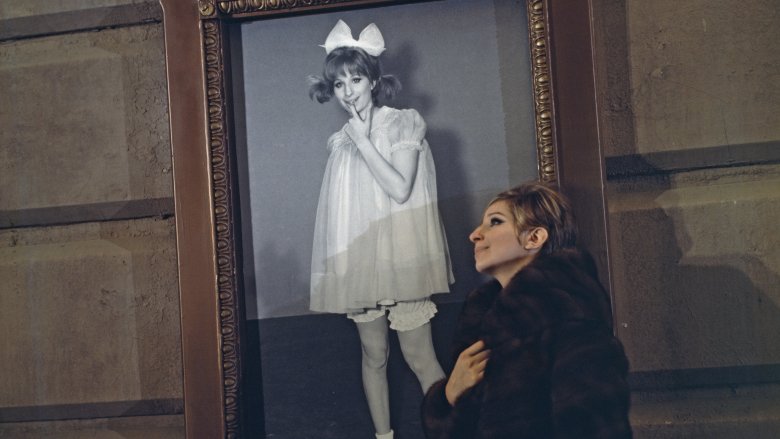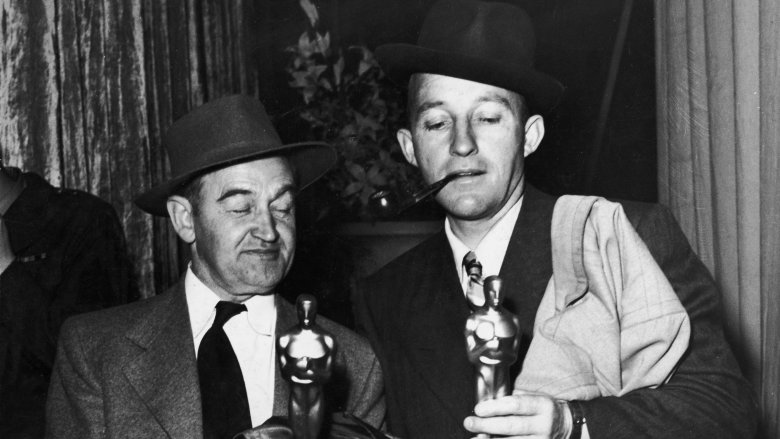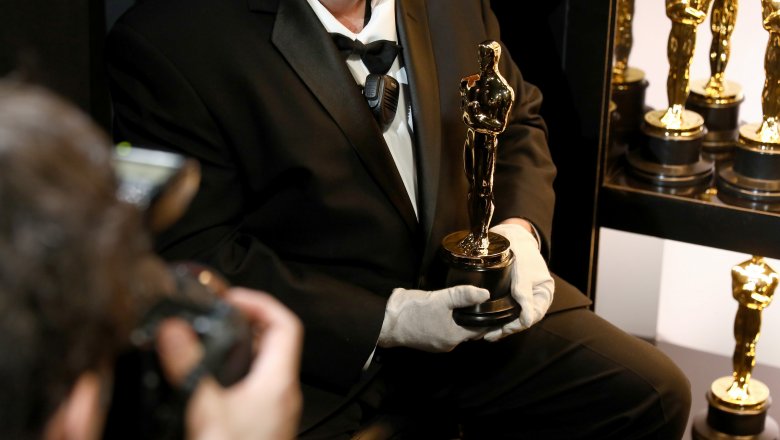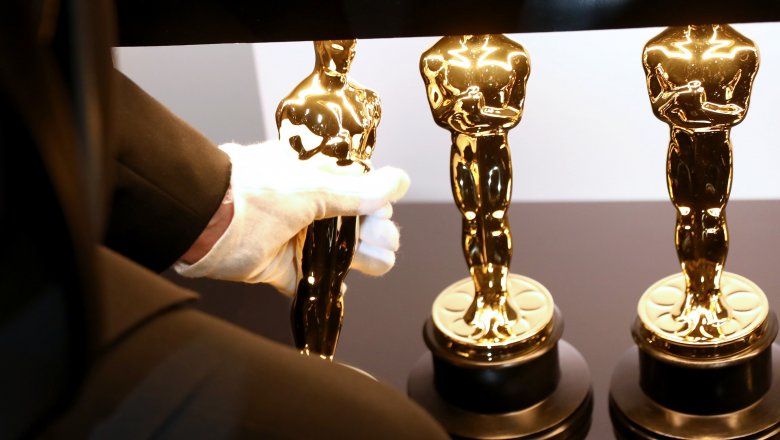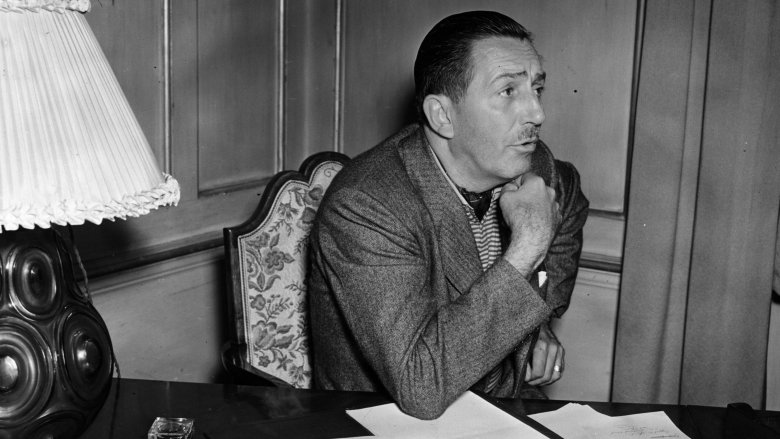The Untold Truth Of The Oscars
In 2019, the Academy of Motion Picture Arts and Sciences will slide closer to a century of awards ceremonies with the 91st Academy Awards, better known to the general public as the Oscars. Though film fans still debate their merit and the political maneuvering that goes on behind the scenes, to the general public the Oscars have long been the gold standard for the best cinema has to offer each year.
The annual awards ceremony is always one of the most-watched television events of the year. Winning an Oscar can take a career to new heights, and the ceremony is always full of surprises. So, as we look ahead to the 91st Oscars, we're also looking back at how we got here, from the addition and removal of various categories to the strangest Oscar victories to that one time dozens of statuettes were stolen. This is the untold truth of the Oscars.
An irregular calendar
For decades now, studios wanting their film to be eligible for an Oscar the following year have had to make sure it's in theaters by December 31. The ceremony follows a simple calendar year — when the Academy says it's honoring the films released in 2018, it means it. That wasn't always the case. For the first six years of its existence, the Academy Awards operated on a calendar more akin to the Emmys than what we now recognize as the Oscars.
The first Academy Awards, which were held on May 16, 1929, honored films released between August 1, 1927 and August 1, 1928. Nominees were not limited to work on a single film, but rather eligible for nomination for their body of work over that time period. Janet Gaynor, the first Best Actress winner, was given her award for work on three different films: 7th Heaven, Street Angel, and Sunrise. In 1934 the Academy began altering their calendar, stretching that year's period of eligibility all the way through December 31, 1933, and by the 7th Academy Awards in 1935, the organization had settled on the calendar year system we now know.
Why is it called an Oscar?
The official name of the famous statuette of the gold man with a sword, designed in the 1920s by MGM art director Cedric Gibbons and sculpted by Los Angeles artist George Stanley, is the "Academy Award of Merit." Nevertheless, it's recognizable to everyone as an "Oscar." Why? Well, it's not entirely clear, and you'll find more than a few articles online attempting to explain it with various versions of the story.
The story the Academy itself has gone with, though, is that the term was coined by Margaret Herrick, who was the Academy's librarian and eventually became its executive director. Upon seeing the now-famous statuette, Herrick is said to have commented that it looked like her uncle Oscar. The Academy made "Oscar" the preferred nickname for its Award of Merit in 1939, but as is often the case with such things, the Hollywood press was using the moniker for several years before that decision.
An open secret
These days, the winners of the Oscars are a closely guarded secret. If all goes well, only the accountants who tabulated the votes know which names are in those envelopes before they're revealed on the live television broadcast. This wasn't always the case. The winners of the first Academy Awards were announced three months before they finally received their statuettes at a banquet in May of 1929.
By the second Academy Awards, things had changed a little. The winners were kept secret in advance of the ceremony, but the names were given to the press ahead of time, with the understanding that they would wait to publish the news until after the winners had been announced. This practice remained in place for a full decade, until 1940 (the year Hattie McDaniel won her historic Oscar for Gone with the Wind), when the Los Angeles Times published the winners list in its evening edition instead of its late edition, which meant guests arriving to the ceremony could grab a paper beforehand and read who won. Since then, the Academy has kept up the system of secrecy we're now familiar with.
A write-in victory
The level of uncertainty at the Oscars varies from year to year. Some years it feels like the major categories are anyone's race, while others feel sewn up weeks before the ceremony even starts. One thing's always certain, though: the name on the envelope is the name of one (or more, which we'll get to in a moment) of the nominees. One time in the Academy's history, though, this was not the case.
The Academy announced in 1935 that voters could disregard the listed nominees and write in a candidate if they so chose, and at the 8th Academy Awards in 1936 that actually resulted in a write-in victory. Hal Mohr won the Best Cinematography Oscar for his work on A Midsummer Night's Dream, making him the first and only Oscar winner in history to have taken the award via write-in. Mohr remains the only write-in winner because the Academy discontinued the write-in practice shortly thereafter.
Cancelled categories
Over nine decades of operation, the Academy Awards have evolved along with the times, and that means a number of changes have been made to the awards themselves and how they're given out. When the awards began in 1929, silent films were still a major part of Hollywood production. In fact, the first Best Picture winner (Wings) was silent. That meant when the Oscars began, there were categories like Best Title Writing to honor the intertitles of silent films, an award that was only handed out at the first ceremony.
Other defunct categories include several Best Short Subject subcategories honoring one-reel films, two-reel films, color films, comedy films, and novelty films. At the first ceremony, the Academy was still dividing the directing category up between drama and comedy. As recently as 1995-1998, the Academy tried a new category, the now-defunct Best Original Musical or Comedy Score Oscar, which was last handed out to Stephen Warbeck for Shakespeare In Love.
The most famous discontinued Oscar of them all, though, is the Academy Juvenile Award, a half-sized statue handed out intermittently to young actors and actresses — including Shirley Temple (the first winner), Judy Garland, and Hayley Mills (the last winner) — for outstanding achievement onscreen that year. The award was initially conceived in the days before Best Supporting Actor and Actress were categories, and was retired as younger and younger stars became capable of winning supporting acting honors.
In case of a tie
Though you can no longer win an Oscar through a write-in vote, it is still very possible for nominees to tie in various categories. In fact, the Academy has honored tied winners six times in its history, most recently in the Best Sound Editing category in 2013 (Paul N.J. Ottosson for Zero Dark Thirty tied with Per Hallberg and Karen Baker Landers for Skyfall). The most famous Oscars tie to date happened in 1969, when veteran Katharine Hepburn (winning her third Oscar for The Lion in Winter) and newcomer Barbra Streisand (for Funny Girl) tied in the Best Actress category, with 3,030 votes each. Hepburn was not at the ceremony, so Streisand took the spotlight and quipped, "Hello, gorgeous," when she was handed her statue.
Ties could still get crazier in the future. According to one source speaking to The Huffington Post, because most of the categories use a winner-take-all system in which the most votes wins, it's possible for more than two nominees to tie. Hypothetically, if there's an even number of voters, and one fifth of those votes for each nominee in a category with five nominations, it would result in a five-way tie, which the Academy would honor by sending everyone in the category home with a statute.
Fragile Oscars
The Oscar is a 13.5-inch-tall, gold-plated statue made of solid bronze. Winners often comment on how heavy it is, weighing in at 8.5 pounds thanks to all that bronze. It's a substantial, weighty (in every sense of the word) honor, and it looks great on a mantle. For a little while in the 1940s, though, winners had to make do with a slightly less glamorous alternative.
Because World War II was in full swing and every spare piece of metal had to go to the military, the Academy could not get the traditional bronze to cast the statuettes. Instead, they made do with plaster facsimiles painted gold, which were significantly more fragile than their metal counterparts. Barry Fitzgerald, who won Best Supporting Actor at the 17th Academy Awards for his role in 1944's Going My Way, actually knocked the head off his plaster statue while practicing his golf swing. After the war, all plaster Oscar recipients were invited to trade their old awards in for the real thing.
The phantom screenwriter
Oscars have been handed out to winners not in attendance many times, and a few times the winners even refused to take the statue. But rarely can we say an Oscar was not handed out because the credited writer didn't really exist. This was the case at least once, though, thanks to the sad and strange saga of screenwriter Dalton Trumbo. Trumbo was a successful Hollywood screenwriter until he ran afoul of Senator Joseph McCarthy's infamous House Un-American Activities Committee because he was a member of the Communist Party.
Trumbo went before the committee in 1947, refused to name names, and was jailed for 11 months. When he left prison, he was blacklisted, and was forced to work using fronts (other writers claiming his screenplays as their own) or pseudonyms in order to continue writing. Under this system, Trumbo won not one, but two Oscars, first for 1953's Roman Holiday (screenwriter Ian McLellan Hunter served as his front) and again for 1956's The Brave One (under the pseudonym Robert Rich). Despite those two wins, Trumbo could not be present to claim the awards, though his family eventually did get them. He was presented with his Oscar for The Brave One in 1975, and his widow received the Roman Holiday Oscar in 1993.
The great Oscars heist
It sounds like something out of a movie, but it really happened. The Oscars have been stolen, but the story's not as exciting as you might think. It begins March 10, 2000, when 55 statuettes were stolen just weeks before the 72nd Academy Awards while they were in transit from Chicago (where they were manufactured) to Los Angeles. Of those statues, which were stolen from an LA loading dock, 52 were found in the trash just nine days later (the man who found them got a hefty reward and tickets to that year's ceremony), while three remained missing. One of those was recovered as part of a drug bust in Florida in 2003, but they remaining two have never been recovered.
Three California men were later given a light sentence in connection with the crime. After the theft was reported, workers at R.S. Owens, the company that makes the statuettes, worked around the clock to get a new shipment of awards to the Academy in time for the March 26 ceremony. In 2017, a representative for the company admitted that might not have actually been necessary, as the stolen statuettes were actually "next year's" supply.
Record wins (and record losses)
Over the course of 90 years, the Academy Awards have filled up their record books, and it's always worth taking a moment to recall the record holders. The most awarded individual in Oscars history is Walt Disney, who won 22 Academy Awards, 10 of which he won in a single eight-year period. Disney also holds the record for most wins in a single year (four), most nominations in a single year (six), and most nominations overall (59).
If you're looking for the most acting Oscars, the honor goes to Katharine Hepburn, who won Best Actress four times. John Ford currently holds the record for most Best Director wins, also with four, while costume designer Edith Head's eight Oscars are the most wins for any woman. If you're looking for the most-nominated actress in Oscars history, that's Meryl Streep with 21, while Jack Nicholson is the most nominated actor, with 12.
The most nominations without a win for an actor? That would be the great Peter O'Toole with eight nominations, though he did eventually get an honorary Oscar. The most total nominations without a win is 16 (not including the nomination he had revoked in 2017), a record held by sound mixer Greg P. Russell. Oh, and if you're looking for most Oscars won by a single film, it's still a three-way tie: Ben Hur, Titanic, and The Lord of the Rings: The Return of the King all share that record with 11 Oscars each.
Long-awaited categories
Though certain Oscar categories seem like ironclad awards that should go without saying, it took a while for various awards to show up. Awards for Supporting Actor and Actress didn't arrive until the 1937 ceremony, and Best Foreign Language Film didn't become an annual category (though foreign films were given special awards earlier) until 1957. Costume Design wasn't recognized until the 1949 ceremony, and between 1939 and 1964 the "Special Effects" Oscar wasn't even divided into different categories for sound and visual effects.
It wasn't until the 2002 ceremony that Best Animated Feature finally became a category, after decades of animated features receiving very little Oscar love (aside from bright spots like the Best Picture nomination for Beauty and the Beast). The inaugural Best Animated Feature award went to Shrek, and continues to be one of the most popular categories of the night for viewers.
The Academy is, of course, still actively courting new category options. Stunt coordinators have been trying for years to get an Oscars category for stunt work, to no avail. In 2018, the Academy itself floated the idea of a new category aimed at "Popular Film." That category has since been tabled pending further discussion.
